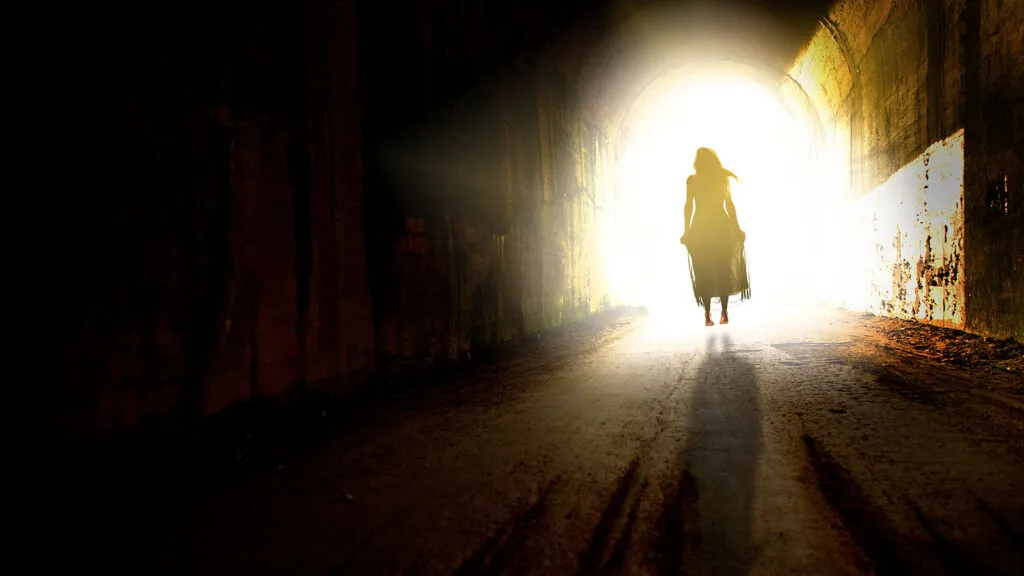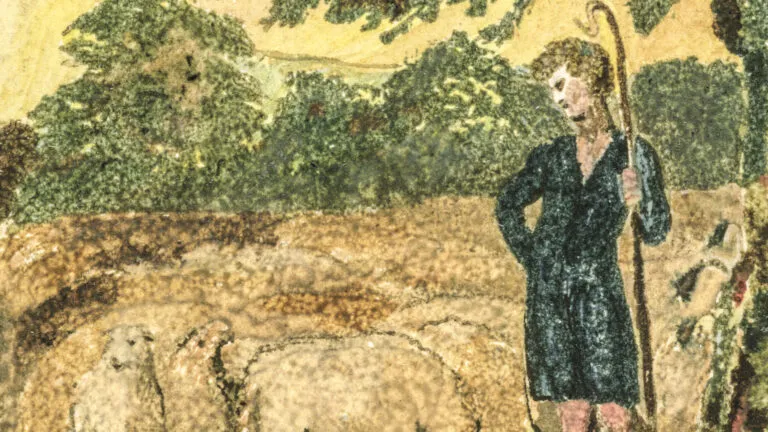Flowers that stretched as far as the eye could see. Light, ethereal and embracing. Peacefulness unlike anything imaginable.
Decades later, the survivors remember every detail. Memories so vivid, their day-to-day lives seem muted. Less real than what they saw when, as children, they were transported somewhere beyond our world. A place where time and space don’t exist. For Ingrid Honkala, it happened when she was nearly three and drowned in a water tank. For Alma Blazquez, it was at age four, suffocated at the hands of an abusive family member. And for Teresa McLean, it was at age three, after accidentally overdosing on aspirin.
They all died and came back. But not before seeing heaven.
The International Association for Near Death Studies (IANDS) estimates that nearly 85 percent of children who undergo cardiac arrest have a near-death experience (NDE). A rate more than twice as high as that for adults—thousands every year. The experiences are not limited by age. There are even reports of infant NDEs, recounted once the child is old enough to articulate their experience. With medical advances, more children on the edge of death are being saved. And stories of their experiences are becoming more common and accepted.
Psychiatrist Dr. Raymond Moody first coined the term near-death experience in his 1975 landmark best seller Life After Life. Dr. Moody, a self-described skeptic, interviewed hundreds of people while researching his book. “The stories are mind-boggling,” he says. “There’s not a medical explanation that holds water.” And yet he gives extra credibility to the accounts of people who experienced NDEs as children. Without preconceptions of the afterlife, their glimpse is as true of a glimpse as you can get.
“When you talk to these children, they have a maturity way beyond their age,” Dr. Moody says. “It’s astonishing what they come back feeling and knowing.”
Children such as Ingrid Honkala, who grew up in the mountains of Colombia. The country was war-torn in the early 1970s. Her young, working parents struggled to get by. Ingrid was small, sickly. One morning, as she and her older sister were playing catch over a large water tank, Ingrid reached for the ball and plunged headfirst into the tank. The water inside was freezing cold from the morning air, and she sank to the bottom. She struggled but soon found herself surrounded by flowers of breathtaking beauty that went on forever. They seemed to lift her upward. Her aching, sickly body was freed of pain. From her vantage point above, she could see the maid in charge blissfully listening to the radio inside the house. She could see her mother walking to work.
Ingrid felt separate from any sort of body. Her spirit was now one with an all-consuming radiance that felt like her one true home. A kind of spiritual womb. She never wanted to leave it. “I went from a place of absolute horror to absolute joy,” Ingrid says. The feeling of joy has never left her.
Alma Blazquez also encountered an otherworldly light at age four in her Chicago home. A relative in a drunken rampage had suffocated her. Suddenly, Alma felt no more pain, only peace. As she reentered her body, she sensed another presence with her. A tall, muscular, all-powerful being who assured her that he was there to protect her. That he would never leave her.
For three-year-old Teresa McLean, there was no soothing presence or light. She left her body inside a German hospital. Her frantic mother had taken her there after Teresa had accidentally eaten two bottles of chewable baby aspirin. In her NDE, Teresa saw two scenes before her, as if on a split screen. On one, doctors and nurses worked tirelessly to revive her. On the other, her mother sat in the waiting room, sobbing. Teresa felt her mother’s emotions—her pain and fear—as if they were her own. It was terrifying.
Then the scene changed. She saw her mother many years into the future. It wasn’t a vision or a dream. No, these images were more real than real. In the future, her parents had divorced. Her mother was overcome with grief, struggling to survive without her daughter. Teresa knew she had to come back. She couldn’t leave her mother. In the next instant, she returned to her body.
Returning to a world that seems diminished is inevitably jarring and disorienting to children. They barely have words to describe what they’re feeling. And trying to make sense of it all can be isolating.
“Not everyone wants to be back,” says Jeffrey Long, M.D., a radiation oncologist and one of the leading researchers of NDEs. “They feel as if they’ve been where they most belong.” Dr. Long is the founder of the Near-Death Experience Research Foundation and author of God and the Afterlife. His organization has recorded more than 4,000 detailed accounts of people who’ve experienced NDEs, both as children and adults.
“The intensity of what the children are experiencing is much greater than what would be normal at their age,” he says. “And the experience generally grows in importance as they get older—whereas it would be natural to expect childhood memories to fade over time. Ninety-five percent of NDE children say the experience was definitely real, meaning not a dream or hallucination.”
Compared to those of adults, child NDEs “tend to be more concrete and less complex,” according to IANDS; there may not be features we typically associate with a NDE, such as a life review. Children are, however, more likely to see deceased loved ones and pets—even relatives they’ve never met. Talking about a NDE, though, can be traumatic. “Many children tend to withdraw,” Dr. Long says. “They find they literally can’t share what happened with anyone.”
Such was the case with Ingrid, Alma and Teresa. Their parents took them to doctors and psychiatrists, desperate to find out what was wrong with them. At an age when most children are content to play outside, Ingrid felt as if she could no longer relate to her family. She stopped eating. She didn’t want to live. “Don’t call me Ingrid,” she told her mother. “I don’t have a name. I don’t need a name.”
Alma stopped talking. She refused to utter a word until age five, when she started school. “My mother told me I was crazy,” she says.
They couldn’t relate to other children. Things that interested other kids, like playing with dolls, seemed babyish. “I was much more interested in adult conversation,” Ingrid says. “Even as a young girl, I suddenly understood everything they were saying.”
All three excelled in school. Ingrid remembers doing difficult math problems and solving complex puzzles easily. Books on philosophy and religion fascinated her. But most of all, the three girls returned with great compassion and love. For people. For animals. For the earth. And for their families. They sensed other people’s suffering and hurts intuitively, as if they were their own struggles. Their experience didn’t always feel like a gift. Alma and Teresa have had frequent premonitions, warning them of tragedies for family and friends. Their otherworldly journey was anything but a once-in-a-lifetime experience; it seemed to open a door to the metaphysical.
“It’s as if they take a piece of heaven with them,” Dr. Long says. “Where the people around them have doubts about God and heaven, they feel a direct connection that grows stronger as they grow older.”
At five, Alma was visited by the same strong, tall man who had comforted her in her NDE. A man she now knew, from church, to be Jesus. “I am with you,” Jesus told her. “I have always been with you and will always be with you.”
Ingrid was visited often by beings of light. They spoke to her and comforted her and made her want to go on living. “Why does no one understand the things about love and life after death that I try to tell them?” she asked them once.
“Because you are special,” the beings told her. “Everyone is special. In time, they will know it too.”
Like many children who experience NDEs, Ingrid, Alma and Teresa all found meaningful careers. Ingrid, who drowned in a water tank, visited the ocean as a girl and felt instantly drawn to it. “I’m going to be an oceanographer,” she told her parents. For a poor girl from Colombia, the very idea was absurd. Especially from someone going on about dreams and fantasies all the time. When Ingrid was older, she had a vision of two large buildings in a campus setting. Buildings she recognized years later when she became an oceanographer at the John Stennis Space Center in Mississippi, studying the effects of climate change.
Teresa, meanwhile, came back for her mother and then devoted her life to helping others struggling with otherworldly experiences. She tells them her story. It’s given her meaning and purpose. In 2012, her mother was dying of esophageal cancer. Teresa sat at her bedside. Her mother, weak, turned to her and said, “I’m staying here because you chose to stay with me.” Her mother, against all odds, lived another three years.
Alma, who met Jesus during and after her NDE, earned a doctorate and worked with an international organization helping children and adults with learning disabilities. She loved running and bicycling, up to 10 miles a day. One day, her bike was struck by a car. Her spine was badly injured. Then an autoimmune disorder set in: lupus. And arthritis. For years, Alma was miserable, barely able to move. The comfort that had always been there was now gone. In 2012, she had a seizure. In the hospital, she again left her body. She was met by an orb of light, its rays powerful and healing.
“You are here because you have come here often,” a voice said. She saw hundreds of people lined up before a stone wall of breathtaking beauty. She wanted to go where they were going. Instead, she saw scene after scene of people she’d helped and with whom she’d shared God’s love. Alma returned to her body, her pain as intense as ever. But she knew, just as she had as a kid, that she wasn’t alone. Within the year, she was completely healed. Today she is able to walk and even teaches advanced yoga.
“We’re all here to love each other,” Alma says. “It gives life meaning.” Ingrid agrees. “Everything is connected,” she says. “We’re all one—that’s what I’ve come to understand.”





